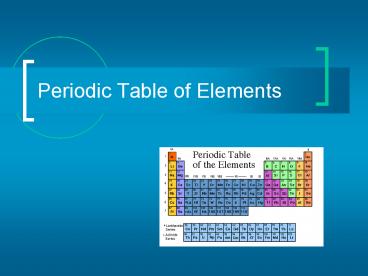Periodic Table of Elements - PowerPoint PPT Presentation
Title:
Periodic Table of Elements
Description:
Periodic Table of Elements Matter All matter is composed of atoms and groups of atoms bonded together, called molecules. Elements Science has come along way since ... – PowerPoint PPT presentation
Number of Views:306
Avg rating:3.0/5.0
Title: Periodic Table of Elements
1
Periodic Table of Elements
2
Matter
- All matter is composed of atoms and groups of
atoms bonded together, called molecules.
3
(No Transcript)
4
chlorine
nitrogen
silver
gold
mercury
oxygen
hydrogen
helium
sodium
niobium
neodymium
carbon
5
Elements
- Science has come along way since Aristotles
theory of Air, Water, Fire, and Earth. - Scientists have identified 90 naturally occurring
elements, and created about 28 others.
6
Elements
- The elements, alone or in combinations, make up
our bodies, our world, our sun, and in fact, the
entire universe.
7
The most abundant element in the earths crust is
oxygen.
8
Periodic Table
- The periodic table organizes the 118 known
elements in a particular way. A great deal of
information about an element can be gathered from
its position in the period table. - For example, you can predict with reasonably good
accuracy the physical and chemical properties of
the element. You can also predict what other
elements a particular element will react with
chemically.
9
Key to the Periodic Table
- Elements are organized on the table according to
their atomic number, usually found near the top
of the square. - The atomic number refers to how many protons an
atom of that element has. - For instance, hydrogen has 1 proton, so its
atomic number is 1. - The atomic number is unique to that element. No
two elements have the same atomic number.
10
Whats in a square?
- Different periodic tables can include various
bits of information, but usually - atomic number
- symbol
- atomic mass
- state of matter at room temperature.
11
Atomic Number
- How many protons an atom of that element has.
- No two elements, have the same number of protons.
Bohr Model of Hydrogen Atom
Wave Model
12
Atomic Mass
- Atomic Mass refers to the weight of the atom.
- It is derived at by adding the number of protons
with the number of neutrons.
This is a helium atom. Its atomic mass is 4
(protons plus neutrons). What is its atomic
number?
13
Symbols
- All elements have their own unique symbol.
- It can consist of a single capital letter, or a
capital letter and one or two lower case letters.
C
Carbon
Cu
Copper
14
Common Elements and Symbols
15
(No Transcript)
16
Groups Periods
- Columns of elements are called groups or
families. - Elements in each family have similar but not
identical properties. - For example, lithium (Li), sodium (Na), potassium
(K), and other members of family IA are all soft,
white, shiny metals.
- Each horizontal row of elements is called a
period. - The elements in a period are not alike in
properties. - In fact, the properties change greatly across
even given row.
17
(No Transcript)
18
(No Transcript)
19
- Families
20
(No Transcript)
21
(No Transcript)
22
(No Transcript)
23
(No Transcript)
24
(No Transcript)
25
(No Transcript)
26
(No Transcript)
27
(No Transcript)
28
(No Transcript)
29
(No Transcript)
30
(No Transcript)
31
Hydrogen
- The hydrogen square sits atop Family AI, but it
is not a member of that family. Hydrogen is in a
class of its own. - Its a gas at room temperature.
32
Mendeleev
- In 1869, Dmitri Ivanovitch Mendeléev created the
first accepted version of the periodic table. - He grouped elements according to their atomic
mass, and as he did, he found that the groups had
similar chemical properties. - Blank spaces were left open to add the new
elements he predicted would occur.































